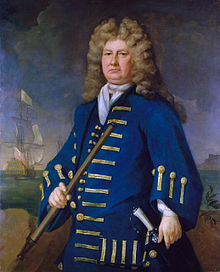
Back كلودسلي شوفيل Arabic Cloudesley Shovell Catalan Cloudesley Shovell Czech Cloudesley Shovell German کلودسلی شوول Persian Cloudesley Shovell French Cloudesley Shovell ID Cloudesley Shovell Portuguese
Sir Cloudesley Shovell | |
|---|---|
 Sir Cloudesley Shovell by Michael Dahl | |
| Born | November 1650 Cockthorpe, Norfolk |
| Died | 22 October or 23 October 1707 Off the coast of Scilly |
| Buried | St Mary's, Isles of Scilly, later moved to Westminster Abbey |
| Allegiance | |
| Service | |
| Years of service | 1664–1707 |
| Rank | Admiral of the Fleet |
| Commands | HMS Sapphire HMS Phoenix HMS Nonsuch HMS James Galley HMS Anne HMS Dover HMS Edgar HMS Monck Irish Squadron Lisbon Station Mediterranean Fleet |
| Battles / wars | |
| Other work | MP for the city of Rochester |
Admiral of the Fleet Sir Cloudesley Shovell (c. November 1650 – 22 or 23 October 1707) was an English naval officer. As a junior officer he saw action at the Battle of Solebay and then at the Battle of Texel during the Third Anglo-Dutch War. As a captain he fought at the Battle of Bantry Bay during the Williamite War in Ireland.
As a flag officer Shovell commanded a division at the Battle of Barfleur during the Nine Years' War, and during the battle distinguished himself by being the first to break through the enemy's line. Along with Admiral Henry Killigrew and Admiral Ralph Delaval, Shovell was put in joint command of the fleet shortly afterwards.
During the War of the Spanish Succession, Shovell commanded a squadron which served under Admiral George Rooke at the capture of Gibraltar and the Battle of Málaga. Working in conjunction with a landing force under the Earl of Peterborough, his forces undertook the siege and capture of Barcelona. He was appointed commander-in-chief of the Navy while at Lisbon the following year. He also commanded the naval element of a combined attack on Toulon, base of the main French fleet, in coordination with the Austrian army under Prince Eugene of Savoy in the summer of 1707. Later that year, on the return voyage to England, Shovell and more than 1,400 others perished in a disastrous shipwreck off the Isles of Scilly.
Along with his naval service, Shovell served as MP for Rochester from 1695 to 1701 and from 1705 until his death in 1707.